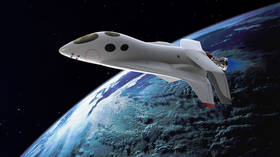Take that! Japanese probe Hayabusa2 fires ‘bullet’ at asteroid in bid to discover how life began

A Japanese space probe on a data-collecting mission has shot a sampling ‘bullet’ into the surface of the Ryugu asteroid, hoping to retrieve organic material that could clue scientists in to how life was first seeded on Earth.
The Hayabusa2 probe used a device called a sampler horn to fire a tantalum projectile “bullet” at the surface of Ryugu, breaking off tiny fragments that are then collected and brought home for analysis. Scientists are on the lookout for amino acids or other organic molecules among the carbon-rich material that makes up C-type asteroids like Ryugu – compounds which could have given rise to the first life on earth under the right reactive conditions.
Also on rt.com Should we be worried? ‘Big Ben-sized’ asteroid to make ‘close approach’ of Earth at 30,000mph todayThe Japanese spacecraft has been shadowing Ryugu for nearly a year, sending first a smaller probe and a trio of mini-rovers down to the rock’s surface over the past few months to collect more specimens. In the next few months, Hayabusa2 is supposed to detonate a mini explosive device on Ryugu’s surface called a Small Carry-on Impactor, creating an artificial crater which will expose other layers of the rock to be sampled by the probe.
[TD1-L08E1] The schedule for the touchdown operation is now on our website. (Exact times may change during the operation.)https://t.co/sT3nTYJZqxpic.twitter.com/VkXV8MHabo
— HAYABUSA2@JAXA (@haya2e_jaxa) February 21, 2019
The bullet sampler works quick, grabbing its cargo in about a second, according to the Planetary Society, which declared the mission a success after a series of minute-by-minute updates.
[TD1-L08E1] On February 22 at 2:09 JST we received this navigation image! The Urashima crater is gradually turning to become visible. In the second image, we increased the magnification and brightness for easier viewing. pic.twitter.com/jN7KZ8DQMh
— HAYABUSA2@JAXA (@haya2e_jaxa) February 21, 2019
The probe’s operators were nothing if not thorough, conducting a test run of the bullet-like sampling mechanism back at the University of Tokyo to confirm it would still work, after the surprise discovery that the surface of the asteroid had a different consistency than expected.
Launched in December 2014, Hayabusa2 spent four years matching speed and direction with Ryugu before sidling up to the asteroid last June. Ryugu is a relatively young asteroid to human eyes –discovered in 1999, it wasn’t even named until 2015– but, like other asteroids, it has been floating through space essentially unchanged for about 4.5 billion years, giving scientists a window into what the solar system looked like in its early days.
Hayabusa2 is (as the name would suggest) the second Japanese craft to visit an asteroid. The original Hayabusa brought home 1,500 particles collected from rocky Itokawa in 2010.
Like this story? Share it with a friend!













